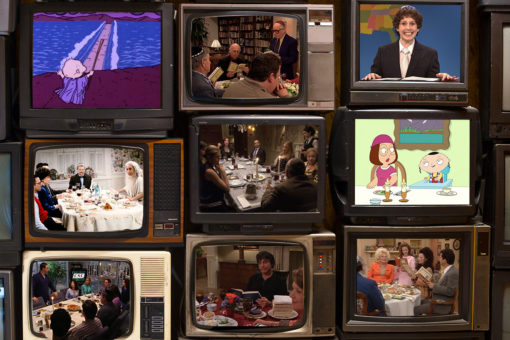This semester, my liberal arts school in Pennsylvania, Dickinson College, has been riddled with controversy: unsolved racist vandalism, upheaval over a student of color’s op-ed in the campus newspaper, and burgeoning white supremacist groups in our town. In the midst of student battles to get the school to address these growing problems, our campus hosted an art exhibit displaying works that that I found to be anti-Semitic.
The art, which depicted the graphic sacrifice of Jews in the Holocaust as animals in the meat trade, was shocking. The artist wanted to convince viewers to give up meat by directly comparing the animal industry to the Holocaust, complete with Nazi propaganda posters and scenes of non-kosher slaughter at Auschwitz. While I found the artist’s work ineffective and offensive (and I’m a vegetarian), I was more upset to find that the gallery staff was totally unprepared for its own exhibit and the reactions it might get.
There was no warning for what we were about to see, and it lacked any nuanced discussion of how Jewish scholars have grappled with this metaphor in the 20th century. For example, writer Isaac Bashevis Singer found the Holocaust an apt comparison for animal cruelty, while Jewish vegetarian activist Roberta Kalechofsky advocates against use of the metaphor. I learned all that after about 15 minutes spent researching online after leaving the exhibit, and didn’t understand why the gallery staff hadn’t done similar simple research.
My friends and I agreed that we should approach the gallery staff to discuss the exhibit. Despite what the staff would later claim in front of me, I never asked for the art to come off the walls or tried to censor anyone’s work — the crux of my argument was rather how the gallery had mishandled their educational duties for the community. I felt they should have talked to the Jewish Life Center or the Judaic Studies department about the exhibit before it opened, given its sensitive nature. It also seemed the student gallery guides could have been more prepared to explain the material to disturbed onlookers. Why did the didactic materials accompanying the artwork not offer opposing viewpoints, or explain the nuances and complexities of anti-Semitic tropes in modern art, I wondered.
Before I met with a staff member of the college gallery, I learned that the staff had held a meeting to discuss some concerned emails from me and other Jewish students and how to move forward — but that meeting didn’t include any Jews. When you don’t invite any Jews to a meeting on anti-Semitism, are you really taking a productive step to tackle it?
I’ll admit I wasn’t feeling fabulous when I went in to meet with the staff member. I was tired and annoyed and, above all, frustrated, but I was determined to hold my ground and explain the views of myself and the other Jewish students I had spoken with. I expected a rational, professional conversation about how staff could move forward with the Jewish community on campus to more carefully and responsibly present the disturbing material.
I was utterly unprepared for the vitriol I received.
Are you aware that there is oppression all over the world?, the staff member asked me, as if this somehow excused or diminished anti-Semitic rhetoric. Are you aware that “other people” had been killed in the Holocaust?, she also asked, which I found to be a thoroughly inappropriate question to demand of a Jew unless they had claimed that no other groups had been persecuted by the Nazis. Are you aware that sometimes art is controversial?
The staff member then asked me to explain why I found the metaphors in the art to be anti-Semitic so she could better understand how it was affecting Jewish students. When I explained our perspective, she shut me down: I had attacked her student curator (I’ve never met the student), I was obsessed with blaming someone (I wasn’t the person who didn’t do basic research before presenting violent material), I was harping on the past (the show had opened a week prior). I objected that asking for a firsthand account of anti-Semitism to help “build inclusive dialogue” and then tone policing a Jewish student’s account actually shuts them out of the dialogue. “I’m not policing your tone,” she interrupted me. “I’m policing your words.”
And so I found myself in more meetings with administrators, explaining myself over and over. I had the gumption to fight, but it was difficult. The staff member made me feel so inferior, like I was half a person to her. Every time I told my story to friends or to the Jewish Life staff, I grew exhausted. At my sixth meeting with administration, I found myself face-to-face with a senior administrator who was also Jewish.
Finally, I felt myself actually listened to and understood. He told me something that I had forgotten in my hurt and anger: that certain things are ingrained in us, things that spark fear or chill in our bones, things that ignite us. We see the word “money” too close to the word “Jew” and we panic. We see an overt metaphor for the Holocaust in media or art where others see a subtle reference to generic oppression. Not everyone is wired like us, just as I do not share the same instinct that might make someone else react in fear to signs of their inherited traumas. These are the intricacies of intercultural communication that we have to specify for one another.
That doesn’t excuse the actions of the staff member. To be frank, it was her job to be prepared for questions from me or any other student, and doubling down on anti-Semitic language to my face was an inappropriate defense. When reached for comment, a spokesperson from Dickinson College said that they “strongly disagree with the characterization of the meeting” but that they do “take these concerns seriously.” They have also planned a panel discussion on “Sue Coe’s Appropriation of Holocaust Imagery: An Evening of Shared Inquiry” for April 3.
Even though I felt like that latest meeting had finally made progress, I still left with a feeling of unease. Would the administrator have heard my concerns — without what-aboutisms, caveats, or silent suspicions of over-exaggeration — if he weren’t Jewish? In meetings with non-Jewish staff, I felt like I needed a translator. With the Jewish administrator, I didn’t need to explain what anti-Semitism felt like or why it mattered. I didn’t have to justify my reactions to being alone in a room with a staff member who launched into an anti-Semitic rant. The Jewish administrator understood my concerns on a fundamental level.
But that sort of representation in school administration is not something afforded to so many students. Where do students of color go when they face discrimination on campus, and no one of their race, ethnicity, or nationality is among the ranks of senior administrators? What do they do if no one has the ability, let alone the understanding, to go to bat for them? What would I do if this administrator had not understood the standpoint knowledge of the Jewish-American experience that influences both discrimination and communication on campuses today?
The staff member had insisted that I was looking for someone to blame. When it comes to discrimination on college campuses, who is to blame? Perpetrators should, of course, be held accountable, but many of us operate in systems where marginalized groups of students are not heard, represented, or respected. Am I to blame for not being more patient with the staff member in explaining my views? Is the gallery to blame for not properly researching the contents of its own exhibit? Or rather, are we all to blame for upholding institutional stratifications of community that set the bar for intercultural understanding so low?



